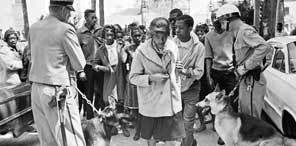In this groundbreaking film, director Jeremy Dean, takes an unflinching look at themes echoed in current events like hurricane Katrina and recent award-winning movies such as “Hustle and Flow” and “Crash”.
Startling newsreel footage–some of it never aired before–brings home the bitter reality of the 1964 Saint Augustine protests led by Dr. King and US Ambassador Andrew Young (who was beaten up on the streets of Saint Augustine by Klan members and other whites violently opposed to desegregation).
The greatest civil rights story never told.
This film is an emotional march from past to present combining rarely seen news footage from 1964 with present day testimony to tell the true story of troubled times in the historic tourist town of St. Augustine, Florida. See African-Americans and their allies in the white community put their lives on the line to force the President of the United States to sign the first civil rights act. The film also takes a look at the aftermath of desegregation and the challenges that it presents to all Americans. In the end we see signs of hope and reconciliation and are challenged to take the next step forward.
The unconventional civil rights film, “Dare Not Walk Alone,” which cuts between the Civil Rights protests of 1964 and the hip hop generation’s struggle to bridge the poverty gap that still exists in many areas of America today.
While Dean tells a story that much of the world has forgotten—the violence and abuse that demonstrators, both black and white, were willing to endure to force the passage of the first Civil Rights Act—he is not content to end the story there. He connects with a segment of American society that is still forgotten, black Americans for whom King’s “Dream” is still just a dream, kids who feel their only way out is hip hop.
Drawing striking parallels between the role of music in black communities during the civil rights movement of the sixties and the way that music still keeps hope alive today, Dean’s film strikes a chord with viewers of all races. Andrew Young, one of King’s top lieutenants, speaks of being beaten by whites opposed to desegregation (Young went on to become Mayor of Atlanta).
James Brock, owner of the Monson Motor Lodge, focus of many demonstrations, gives his first ever on-camera interview (King was arrested at the Monson and acid was used to remove protesters from its “Whites Only” swimming pool). Dean has created a visceral mix of newly discovered archival footage and eyewitness accounts from people on both sides of the events which led directly to passage of the Civil Rights Act of 1964. His footage of a service of reconciliation held at a white church that had barred blacks from worshiping in the sixties, shows progress is possible. And audiences of all ages have repeatedly been moved to ask: What more can we do to help?
For anyone trying to make sense of recent events in places like Jena, Alabama, or the aftermath of Hurricane Katrina, this film might be a good place to start.
The film offers signs of hope, yet the economic data speak for themselves: glaring gaps still exist within American society. However, if the first step to closing them is facing the problem, viewers of this film are taking that step.
Website: www.darenotwalkalone.com
Discover more from HISTORIC CITY NEWS
Subscribe to get the latest posts sent to your email.



Comments are closed